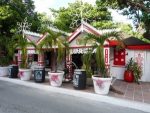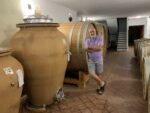Dassaï Saké
This week I chose not to go to discover a wine but, instead, a typically Japanese beverage: the Saké.
“Asahi Shuzo or the art of producing exceptional sakes.”
 Let us start to meet one of the younger Japanese breweries: The Asahi Shuzo brewery.
Let us start to meet one of the younger Japanese breweries: The Asahi Shuzo brewery.
Despite the title of the youngest brewery in Japan this company, located in the Prefecture of Yamaguchi in Japan, has a history spanning 240 years.
Today its flagship brand is the brand Dassaï (created 20 years ago by the current CEO, Hiroshi Sakurai). This brand is currently present (only) on the premium sake market and each year produces near 16.4 million bottles.
Originally sake was a sacred drink produced to be given as offerings during religious festivals.
What does Dassaï ?
 “Dassaï” is one of the letters of the Japanese name of the village (Kawakami) where the distillery is located. The Japanese name of the locality can be translated as “otter passage,” the name given in reference to a local legend tells an old otter turned into a child through the village of Kawakami.
“Dassaï” is one of the letters of the Japanese name of the village (Kawakami) where the distillery is located. The Japanese name of the locality can be translated as “otter passage,” the name given in reference to a local legend tells an old otter turned into a child through the village of Kawakami.
What Dassaï is looking for when they make sake ?
Sakes combining modernity and respect for ancestral traditions. Of “Good sake to drink, not to get drunk but to enjoy” happily, with friends or family.
How Sake is produced ?
Above all we must know that sake is made from three products: the spring water, yeast and rice (the most noble variation is the Yamada Nishiki). Some sakes use a single variety of rice or combine other two varieties. The choice of water is as important as the selection of the rice variety .
A little bit of anatomy before explaining, a rice grain consists of a heart of starch and protein layer, vitamins and fats. These external parties are rice harmful to the development of sake, and we must remove them. Polishing consists in removing the outer layers of rice. There are different intensities expressed by polishing the “Seimaibuai” (polishing rate). More rice is polished over the quality of sake is great but the less is the quantity produced.
Simply put, a polishing rate of 23 indicates that 77% of the volume of the grain was removed during this process. At Dassaï polishing can take up to 144 hours.
 2 – Wash the rice called “Senmai“
2 – Wash the rice called “Senmai“
In the previous step the rice has undergone through a very strong dehydration because of the frictional forces causing the polishing. In order that the natural moisture finds its starting level again, the rice is soaked in vats filled with water. Once the rate is back to normal, is washed rice.
 3 – Steaming the “Mushimai” Rice
3 – Steaming the “Mushimai” Rice
The rice is cooked in large wooden barrels or stainless steel. The objective of this step is to get a rice that when cooked is soft outside and hard inside (so it can pass the best conditions for 45 days of fermentation). Once cooked rice is partially cooled it is maintained at moisture content close to 50%. The degree of cooking rice in part determines the aromatic complexity of the final product.
 4 – Preparation of Kojis – one of the most important manufacturing steps.
4 – Preparation of Kojis – one of the most important manufacturing steps.
Once the step called “hikikomi” (cooling and humidity) is finished, the rice is spreaded on a flat surface and sprinkle yeast / spores koji (koji-kin ie Aspergillus oryzae). Here we let the spores grow, break the starch molecules and produce enzymes required for fermentation of rice. The process takes about 48 hours.
5 – Shubo
 Once the koji stopped in its evolution it is put into vats and mixed with cooked rice, water and lactic acids. Koji will transform the rice starch into glucose, glucose which in turn will feed the yeast and facilitate fermentation.
Once the koji stopped in its evolution it is put into vats and mixed with cooked rice, water and lactic acids. Koji will transform the rice starch into glucose, glucose which in turn will feed the yeast and facilitate fermentation.
6 – Fermentation called “moromi“
The glucose by the action of the yeast, will turn into alcohol.
7 – Pressing
This is a step to separate the sake from the lees of sake fermented non-refined (moromi). In addition to the conventional press, Asahi Shuzo uses centrifuges to perform this step, it was the first brewery in the world to do so.
The sake is then separated from the lees (solid part) without using a pressure force in order to fully express the flavors and a certain roundness that a premium sake must have.
8 – Ageing
Some sake age in wood barrel 14 to 36 months.
 Which is the difference within the Sake ?
Which is the difference within the Sake ?
The water quality, the rice variety as well as techniques and materials used for the development are key elements that will impact the final flavor. It would be wrong to think that all look alike…. There are as many differences between two sakes as they are between two wines.
The classification of sake :
 The current categorization is based on two criteria: the polishing rate of the rice and the addition or not of industrial alcohol. The main “grades” are synonymous with quality three in number:
The current categorization is based on two criteria: the polishing rate of the rice and the addition or not of industrial alcohol. The main “grades” are synonymous with quality three in number:
– Daiginjo: Polishing greater than 50%. This is the ultimate in quality for the sake, the equivalent of our Grand Cru Classé of Bordeaux.
– Ginjo: Made from rice polished to 40% or 50%. It is therefore of high quality sake.
– Honjozo: Sake made from rice polished to 30%. It is thus sake of good quality.
For the little anecdote:
You should know that unlike our habits, Japan sake is drunk regularly and accompanies dishes in the same way that wine accompanies our Western dishes.
Have a good week and Kampai!*
*santé
Thanks to Kaoru IIDA (Asahi Shuzo) and Hideyuki Ishino (Workshop Isse) for their warm welcomes.
Jonathan Choukroun Chicheportiche
Asahi Shuzo website
Dassaï Facebook
Workshop Issé Website
Workshop Issé
11 rue St Augustin
75002 Paris (FRANCE)
01.42.96.26.74






